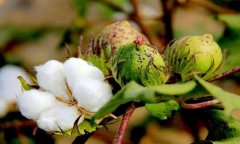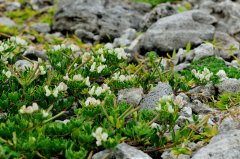How to kill pests without pesticides in farmland? The importance of environmental diversity in pest regulation
The ultimate goal of farming is to produce food, but crops spend most of their time in the field as habitat for animals before they are brought to the table. Some animals inhabit fields without affecting crop yields, but some affect crop yields and quality. These are pests in human eyes. The most important way to reduce pests is to rely on natural enemies to achieve biological control effect through predation or parasitism. However, the effect of biological control is different in each field, and the most important reason is the field environment itself.

The Hualien Agricultural Improvement Farm once experimented with 60 hectares of organic land, choosing a field of cabbage divided into small plots, and sowing a row of papaya seeds in the middle. When marigolds bloomed, they attracted a large number of aphids, and the aphids on the surrounding cabbage were eaten. At that time, larvae and pupae of aphids could be seen everywhere on the cabbage leaves. However, if the same method was changed to another field surrounded by customary operations, no insects would be interested after marigolds bloomed. It can be seen that when various biological groups are established in an environment where chemicals are not used for a long time, as long as appropriate conditions are given, they can quickly gather and reproduce.
In another study, researchers surprised researchers by finding more species and numbers of invertebrates and beneficial predators in pesticide-treated rice fields in village A than in organic rice fields in neighboring village B. After careful observation of the environment of the paddy fields in the two villages, it was found that the traditional grassy fields around the paddy fields in Village B had been replaced by cement fields, while the paddy fields in Village A still maintained natural grassy fields. Therefore, even after several pesticides were applied to the paddy fields in a village, a certain proportion of beneficial natural enemy populations could still be maintained in the paddy fields. It is not difficult to understand this because the surrounding grassy fields are long-term stable vegetation habitats, providing space for beneficial insects to temporarily avoid pesticide threats.
The main incentive for these beneficial predators to appear in the field is "SNAP", S means Shelter, N means Nectar, A means Alternative food, P means Pollen.
In both habitat and alternative food segments, it is often necessary to rely on a variety of plants to provide shelter for beneficial predators such as arthropods and a variety of food sources. In the nectar and pollen part, it can provide sufficient energy source for predatory and parasitic beneficial natural enemies, because most nectar contains 13-15 amino acids, including essential amino acids for insect growth and development. They can obtain carbohydrates, nitrogen, lipids, vitamin C, potassium and sodium from nectar. With regard to the selection of flower species, some studies have pointed out that if it is necessary to attract natural enemies such as parasitic bees, Umbelliferae (Umbelliferae) has the best effect due to its large number of flowers, followed by Compositae (Compositae), Leguminosae (Leguminosae) and Polygonaceae (Polygonaceae).
Compositae plants contribute significantly to biological control functions in farmland in subtropical Taiwan. The Hualien Agricultural Improvement Farm research team planted Taiwan's native Compositae plants such as Malan and Yellow Nectar in the orchard rows of Wendan. The investigation found that these orchards had 2.4 times more parasitoid wasps than ordinary orchards without grass. If specific parasitoids were released artificially, their survival life span in orchards could be extended and the chances of pests being parasitized increased.
Another study attempted to plant a 200-metre strip of flowering Compositae plants next to a paddy field in a rice production zone. The relative abundance of parasitic insects in the paddy field was 1.7-2 times higher than that in other paddy fields, and the fluctuation of the density of major pests in the paddy field was more gradual, so that there was no sudden increase of pests in a short period of time.
If the landscape scale of farmland is enlarged, the landscape state of several kilometers is also a factor affecting the biological control function of farmland. Japanese researchers have found that if rice fields are adjacent to forests, the semi-natural grassland belt at the junction is usually a hot spot of biodiversity. In the mainland of China, it was also found that the alternate arrangement of crop and non-crop vegetation was helpful to buffer the occurrence of pests. It was suggested that the width of rice field should not be more than 200 meters and some different vegetation should be kept in the middle to maintain the biological control function of rice field in nature.
Similar research has been done in Taiwan. The Hualien Agricultural Improvement Station has compared the pest control functions of rice fields in the rice production area surrounded by shallow mountains and in the plain rice production area. After two cropping periods in a year, it was found that in the case of shallow mountains and diversified habitats, when the density of planthoppers increased, the number of their natural enemies increased, and the density of planthoppers was controlled immediately and decreased. However, when the number of planthoppers increased in large rice production areas, the above effects did not occur.
In short, the more diverse the vegetation surrounding the farmland, the more beneficial it is to biological pest control. This also means that farming in this environment has an advantage over others in not using drugs.
- Prev

The transformation effect of cotton planting on soil, the harm of cotton planting to soil is very great?
India is an important cotton producer in the world, however, there are few non-genetically modified cotton seeds in India because there is something wrong with the original cotton seeds. This is what we can't feel at the end of consumers and users. About ten
- Next

What kind of plant is the hundred-vein root of Orchid Island in Taiwan? What are the characteristics of the hundred vein root of Orchid Island? what does it look like?
The name of the hundred vein root of Orchid Island is special, and it is easy to make people wonder what the plant named after the hundred vein root looks like, which makes plant lovers always want to find out. The root of Orchid Island belongs to the family Fabaceae, Lotus, which has only 2 species in Taiwan.
Related
- A course of planting techniques and methods on how to grow carrots
- How to plant the latest tulips?
- Is it better to pick tea in the morning or in the afternoon? When is the best time for tea to be picked? what is the third or fifth tea?
- Launch Yuanxiao Happy combination Haocha + Tea Yuan healthy Taste
- Penghu Tourism "Fireworks 20 Parade with You"
- 2022 West Lake Happiness holds "Digital Revitalization Voucher" and draws iphone13 and laptop.
- Banqiao Fuzhou social houses are designed to change start-up combined with police elimination to create a safe and livable environment
- The convenient measure of "mechanical weeding" in Xinbei has been abused and the Agriculture Bureau has imposed heavy penalties on the illegal land consolidation.
- Changgeng University Joins Hands with Four Memory Factories to Rescue Memory Talent Shortage
- The list of Taiwan's top 100 MVP managers is listed by the Director-General of the Farmers' Association of Sanxia District.

